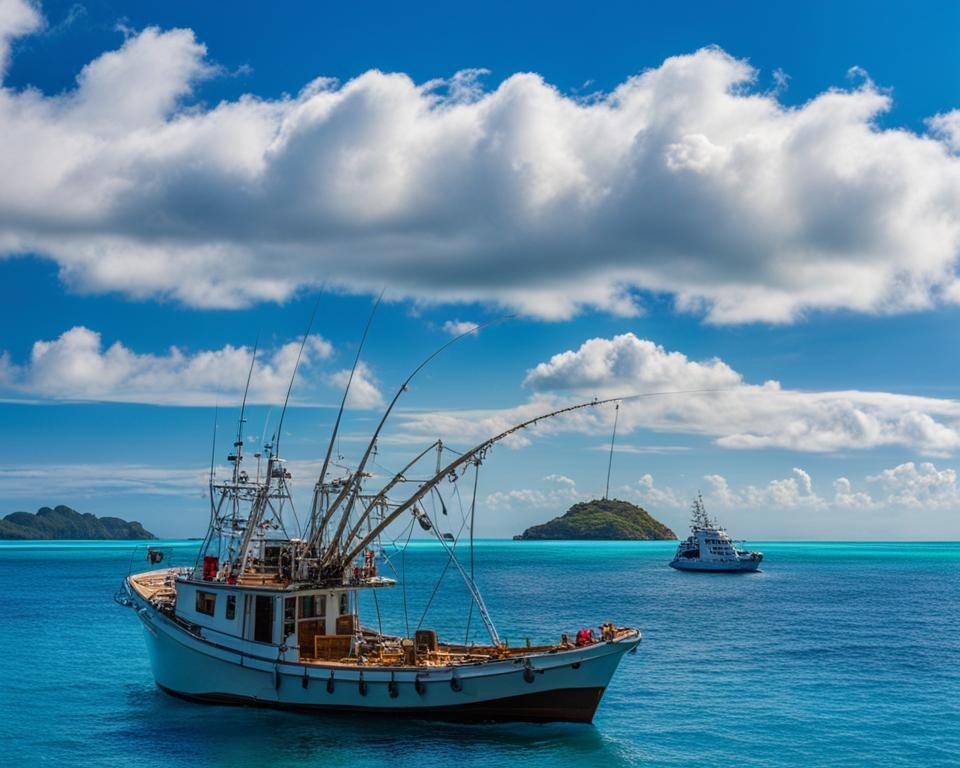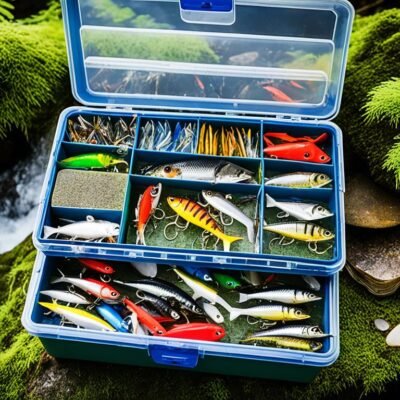Welcome to our comprehensive guide on fly fishing essentials for both beginners and experienced anglers. Whether you are just starting out or looking to enhance your fly fishing skills, this article will provide you with the fundamental knowledge you need to succeed. From the right gear to valuable tips and techniques, we’ve got you covered.
Let’s dive in and explore the world of fly fishing gear, tips, techniques, and even some amazing destinations to fuel your angling adventures. Whether you’re a beginner or a seasoned pro, we have something for everyone in this guide.
First and foremost, we’ll help you choose the right fly fishing gear. From rods to reels, lines to accessories, our expert tips will ensure you have everything you need for a successful angling experience. And if you’re a beginner, don’t worry – we’ll guide you through the basics and help you make informed decisions.
Next, we’ll delve into the art of fly fishing techniques. From casting to mending, we’ll cover the essential techniques that will improve your presentation and increase your chances of landing that prized catch. Whether you’re a beginner or looking to master advanced techniques, our tips and insights will take your fly fishing skills to the next level.
Once you’ve honed your skills, it’s time to explore the best fly fishing destinations. Whether you prefer freshwater or saltwater, remote wilderness areas or popular hotspots, we’ll highlight some incredible locations known for their abundant fish species. Get ready to plan your next fly fishing adventure.
For beginners who want a more immersive learning experience, we’ll also discuss the benefits of fly fishing classes. Professional instruction can fast-track your progress and provide invaluable insights to accelerate your fly fishing journey.
Planning a fly fishing trip? We’ve got you covered there too. Our expert tips on organizing your adventure, researching local regulations, and finding experienced guides will ensure you have a memorable angling experience.
To help both beginners and pros alike, we’ll share a range of fly fishing tips and tricks. From reading the water to selecting the right fly patterns, our expert advice will enhance your angling skills and increase your chances of success.
Maintaining and caring for your fly fishing gear is crucial for optimal performance. We’ll provide guidelines on how to clean, store, and maintain your equipment, ensuring it lasts for many seasons of successful fly fishing.
Lastly, for our experienced anglers, we’ll explore advanced fly fishing techniques that will challenge and excite you. From spey casting to Euro nymphing, you’ll learn specialized techniques to tackle even the most demanding fishing situations.
Get ready to embark on an exciting journey into the world of fly fishing. Let’s dive in and explore the fly fishing essentials that will take your angling skills to new heights!
Choosing the Right Fly Fishing Gear
Selecting the appropriate fly fishing gear is crucial for a successful angling experience. Having the right tools can make all the difference in landing that trophy catch. In this section, we will guide you through the process of choosing the best fly fishing gear, including rods, reels, lines, and accessories.
Best Fly Fishing Rods
When it comes to fly fishing rods, there are various options available to suit different fishing styles and preferences. From lightweight and sensitive rods for delicate presentations to powerful rods for casting long distances, finding the right rod is essential. Popular brands such as Orvis, Sage, and G. Loomis offer a wide range of high-quality fly fishing rods for both beginners and seasoned anglers.
Fly Fishing Reels
A well-balanced reel is crucial in maintaining control and landing your catch. Look for reels that are durable, lightweight, and have a smooth drag system. Brands like Hatch, Abel, and Ross Reels are known for their reliability and performance in various fishing conditions.
Fly Lines and Leaders
Choosing the right fly line is essential for casting accuracy and presentation. Opt for a line that matches your rod weight and the type of fishing you’ll be doing, whether it’s freshwater or saltwater. Additionally, selecting the appropriate leader and tippet strength is crucial for successful fly fishing. Brands like Scientific Anglers, Rio, and Airflo offer a wide selection of fly lines and leaders for different fishing scenarios.
Fly Fishing Accessories
While rods, reels, and lines are the essential components, there are several accessories that can enhance your fishing experience. These may include fly boxes, flies, fly tying tools, waders, boots, and fishing vests. The right accessories will not only streamline your fishing process but also make it more enjoyable. Brands like Fishpond, Umpqua, and Simms offer a variety of high-quality fly fishing accessories to meet your specific needs.
When choosing your fly fishing gear, it’s important to consider your skill level and budget. Beginners may opt for entry-level gear that provides excellent value for the price, while more experienced anglers may invest in higher-end gear for optimum performance. Don’t hesitate to seek advice from seasoned anglers or visit a reputable fly shop to get personalized recommendations based on your fishing goals and preferences.
Mastering Fly Fishing Techniques
Fly fishing techniques are the key to successfully presenting your fly to the fish. By mastering these techniques, you can improve your chances of hooking that prized catch. In this section, we will dive into various casting techniques, as well as explore other important skills that every fly angler should know.
Casting Techniques:
One of the fundamental skills in fly fishing is casting. Proper casting techniques allow you to place your fly accurately and delicately on the water. There are several casting techniques that you can learn and practice to enhance your fly fishing experience.
1. Overhead Cast:
The overhead cast is the most commonly used casting technique. It involves casting your line forward and bringing it back behind you in an arcing motion. This technique allows you to cover a wide range of distances and is ideal for targeting fish in open water.
2. Roll Cast:
The roll cast is a handy technique when you have limited space behind you for a backcast. It involves rolling your line on the water’s surface to generate enough energy to propel the fly forward. This technique is particularly useful when fishing in tight spaces or casting against strong currents.
3. Reach Cast:
The reach cast is a variation of the overhead cast that helps you avoid spooking fish by reducing the drag on the fly. By extending your rod and creating a slight upstream mend when casting, you can achieve a drag-free presentation. This technique is effective when fishing in currents or when targeting wary fish.
Other Key Techniques:
In addition to casting, there are several other techniques that can improve your fly fishing success. They include:
1. Mending:
Mending involves manipulating your fly line on the water’s surface to control the drift of your fly. By creating slack or tension in the line, you can achieve a natural presentation, allowing your fly to drift naturally with the current.
2. Stripping:
Stripping is the technique of retrieving your fly by pulling the line in short, quick bursts. This mimics the movement of a baitfish or insect and can entice fish to strike. Varying the speed and pattern of your strips can help trigger more strikes.
3. Hook-Setting:
Hook-setting is the act of driving the hook into the fish’s mouth once it strikes your fly. It requires a quick and firm motion to ensure a solid hook-up. Proper timing and finesse are crucial to prevent the fish from escaping.
By honing your skills in these fly fishing techniques, you will have the confidence to tackle various fishing situations and increase your chances of landing more fish. Whether you are a beginner or experienced angler, mastering these techniques will elevate your fly fishing game to new heights.
Exploring Fly Fishing Destinations
Embark on a journey to some of the world’s most remarkable fly fishing destinations. Whether you find solace in untouched mountain streams or crave the adventure of the remote wilderness, these popular hotspots cater to anglers of all levels. Immerse yourself in the beauty of nature as you cast your line and embrace the thrill of reeling in the perfect catch.
If you prefer the tranquility of freshwater, consider visiting the breathtaking rivers of Patagonia, where crystal-clear waters are home to a wide variety of trout species. Or, venture to the San Juan River in New Mexico, renowned for its year-round abundance of trophy-sized trout.
For saltwater enthusiasts, the stunning flats of the Bahamas offer unparalleled opportunities to chase bonefish, tarpon, and permit. The Florida Keys provide a diverse ecosystem where you can encounter everything from snook and redfish to the elusive and highly prized bonefish.
In Europe, the River Tweed in Scotland and the River Test in England are iconic destinations for fly fishing enthusiasts. Both rivers boast a rich history and offer the chance to catch salmon and brown trout amidst breathtaking landscapes.
No matter which destination you choose, each offers its own unique allure and promises an unforgettable fly fishing experience. So, pack your gear and prepare for an adventure that will leave you with cherished memories and a desire to explore even more fly fishing destinations around the globe.
Taking Fly Fishing Classes
Are you new to fly fishing or looking to sharpen your skills on the water? Enrolling in fly fishing classes can be a game-changer. Professional instruction offers numerous advantages that can accelerate your learning curve and boost your confidence on the river. Whether you’re a beginner fly fisherman eager to master the fundamentals or an experienced angler seeking advanced techniques, these classes are designed to cater to all skill levels.
In fly fishing classes, you can expect a structured curriculum that covers everything from casting techniques to fly selection. Expert instructors will guide you through the intricacies of the sport, providing hands-on demonstrations and individualized feedback to help you improve your technique and increase your chances of success on the water.
One of the key benefits of taking fly fishing classes is the opportunity to learn from experienced professionals who have honed their skills over many years. They possess valuable insights and knowledge that can significantly enhance your understanding of the sport. These instructors can offer personalized guidance and answer any questions you may have, empowering you to become a more effective and knowledgeable angler.
When selecting a fly fishing class, it’s essential to consider reputable schools or programs that prioritize safety, sustainability, and conservation. Look for instructors who are certified and have a deep passion for fly fishing. Research their credentials and read reviews from past students to ensure that the class meets your expectations.
Beyond the practical skills, fly fishing classes also provide a valuable opportunity to connect with fellow anglers who share your enthusiasm for the sport. Building connections within the fly fishing community can open doors to new fishing opportunities, lifelong friendships, and a supportive network that can accompany you on future angling adventures.
Whether you’re interested in casting like a pro, mastering advanced techniques, or simply getting started with the basics, fly fishing classes offer an ideal platform to gain the knowledge, skills, and confidence needed to succeed on the water. So, seize the opportunity to dive deeper into the world of fly fishing and embark on an educational journey that will undoubtedly enhance your angling experience.
Planning Fly Fishing Trips
When it comes to planning a fly fishing trip, there are several factors to consider to ensure a memorable and successful adventure. From selecting the right destination to researching local regulations, careful planning is key. Here are some insights and tips to help you organize your next fly fishing trip.
Choosing the Perfect Fly Fishing Destination
One of the first steps in planning any fly fishing trip is choosing the right destination. Fly fishing destinations come in all shapes and sizes, offering a wide range of experiences. Whether you’re interested in casting for trout in mountain streams or targeting bonefish in tropical flats, there’s a destination that suits your preferences.
Research various fly fishing destinations that are known for their abundance of fish species and scenic beauty. Consider factors such as accessibility, fly fishing seasons, and the types of fish you want to target. Whether you prefer freshwater or saltwater fly fishing, there are plenty of options to explore.
Timing is Everything
Choosing the right time of year for your fly fishing trip is crucial. Different seasons bring different hatches and fish behavior, so it’s essential to consider the timing of your adventure. Research the peak fishing seasons for your chosen destination and plan your trip accordingly.
Additionally, be aware of any potential weather patterns that may impact your fly fishing trip. While it’s impossible to control the weather, being prepared for different conditions can make a significant difference in your overall experience.
Understanding Local Regulations
Before embarking on your fly fishing trip, familiarize yourself with the local fishing regulations. Each fishing destination may have specific rules and restrictions, such as catch limits, fly fishing only areas, and required licenses. Failure to adhere to these regulations can result in fines or other penalties, so it’s crucial to do your homework beforehand.
Contact local fishing authorities or visit their websites for detailed information on fishing regulations, permits, and any special requirements you need to meet. It’s also a good idea to reach out to local fishing clubs or experienced anglers in the area for additional insights and recommendations.
Enlist the Help of Experienced Guides
When planning a fly fishing trip to an unfamiliar destination, enlisting the help of experienced guides can greatly enhance your experience. Local guides possess valuable knowledge of the area, including the best fishing spots, fly selection, and techniques specific to the region.
Research reputable fly fishing guide services in your chosen destination and read reviews from previous clients. Experienced guides can provide valuable insights and ensure you make the most of your time on the water.
Remember, planning a fly fishing trip is not just about catching fish—it’s about immersing yourself in nature, connecting with the outdoors, and creating unforgettable memories. By considering these factors and taking the time to plan your trip, you’ll increase your chances of having a successful and enjoyable fly fishing adventure.
Fly Fishing Tips and Tricks
Whether you’re just starting out or have been fly fishing for years, there are always new tips and tricks to enhance your skills and improve your chances of a successful angling experience. In this section, we will share expert advice on various aspects of fly fishing that will help you become a more accomplished angler.
Reading the Water
One of the most crucial skills in fly fishing is the ability to read the water. By understanding the different types of water currents, structures, and features, you can identify the most productive areas where fish are likely to be hiding. Look for riffles, pools, runs, and eddies, as these are prime locations for fish to feed and seek shelter.
Selecting the Right Fly Patterns
Choosing the appropriate fly pattern can make all the difference in enticing fish to strike. Pay attention to the insects and other aquatic life present in the area you’re fishing. Match your fly patterns to the natural food sources available, such as mayflies, caddisflies, or aquatic nymphs. Experiment with different sizes, colors, and styles to find what the fish are most responsive to.
Understanding Fish Behavior
Having a good understanding of fish behavior can greatly improve your success on the water. Learn about the specific fish species you’re targeting, their feeding habits, preferred water temperatures, and preferred habitats. This knowledge will help you strategize your approach and present your flies in a way that mimics natural prey, increasing your chances of enticing a bite.
Improving Casting Accuracy
Accurate casting is essential for presenting your fly precisely where you want it to be. Practice your casting technique to develop accuracy and distance control. Focus on maintaining a smooth and controlled stroke, avoiding abrupt movements that can spook fish. Use the power of your wrist and forearm to generate line speed and delivery accuracy.
By applying these fly fishing tips and tricks, you can develop the skills and knowledge necessary to become a more successful angler. Remember, practice and patience are key, so get out on the water and continue to refine your techniques. Whether you’re a beginner or seasoned pro, there’s always room to grow and improve in the exciting world of fly fishing.
Maintaining and Caring for Your Fly Fishing Gear
Proper maintenance and care of your fly fishing gear are essential to ensure its longevity and optimal performance. By following a few simple guidelines, you can keep your fly fishing equipment in top shape and ready for your next angling adventure.
Cleaning Your Fly Fishing Gear
After a day on the water, it’s important to clean your fly fishing gear to remove dirt, debris, and any potential contaminants. Rinse your rods, reels, and lines with freshwater to remove any salt, sand, or other residue. Use a soft cloth and mild soap to gently clean the surfaces, taking care not to scratch or damage any components. Dry your gear thoroughly before storing to prevent the growth of mold or mildew.
Storing Your Fly Fishing Gear
Proper storage is key to preserving the quality and functionality of your fly fishing gear. Store your rods in a rod tube or rack to protect them from accidental damage or bending. Avoid exposing your gear to extreme temperatures, as this can weaken the materials and affect performance. Keep your fly lines and reels in cool, dry places to prevent warping or corrosion.
Regular Maintenance and Inspections
In addition to cleaning and storage, regular maintenance and inspections are crucial for your fly fishing gear. Check your rod guides for any signs of wear or damage and replace them if necessary. Inspect your reels for any loose or missing parts, and lubricate the moving components for smooth operation. Examine your fly lines for cracks or fraying and replace them if they show signs of wear. By conducting regular maintenance and inspections, you can catch potential issues early and prevent them from becoming significant problems.
Safeguarding Against Wear and Tear
While fly fishing gear is designed to withstand the rigors of angling, it’s essential to take precautions to prevent unnecessary wear and tear. Avoid dropping or mishandling your equipment, as this can lead to damage or breakage. When on the water, be mindful of any obstacles that could snag or tangle your line, potentially causing it to snap. By exercising caution and treating your gear with care, you can extend its lifespan and enjoy many more seasons of successful fly fishing.
Caring for your fly fishing gear is not only about protecting your investment but also ensuring optimal performance on the water. By following these tips and guidelines for maintenance, cleaning, and storage, you can keep your gear in excellent condition and ready for your next fly fishing expedition.
Advanced Fly Fishing Techniques for Pros
For experienced fly anglers looking to take their skills to the next level, it’s time to explore advanced fly fishing techniques. These specialized techniques, including spey casting, Euro nymphing, and dry-dropper rigging, can give you an edge when facing more challenging fishing situations.
Spey casting is a technique commonly used in larger rivers or when dealing with wind. It allows for longer casts and is especially effective when targeting salmon or steelhead. Euro nymphing, on the other hand, is a versatile technique that originated in Europe. It involves using weighted nymphs and relies on tight line control to detect subtle strikes from trout. Dry-dropper rigging is another advanced technique that pairs a dry fly with a subsurface nymph. This setup increases your chances of enticing fish that are actively feeding at different depths.
So, when should you use these techniques? Spey casting is ideal for situations where traditional casting techniques may be limited by space or obstacles. Euro nymphing is highly effective in rivers with strong currents or when fish are feeding close to the bottom. Dry-dropper rigging shines when fish are selectively feeding on the surface but may also be taking subsurface offerings.
By adding these advanced fly fishing techniques to your arsenal, you’ll have the tools to tackle any angling challenge that comes your way. Remember, practice makes perfect, so take the time to perfect these techniques and adapt them to different fishing scenarios. Happy fishing!




